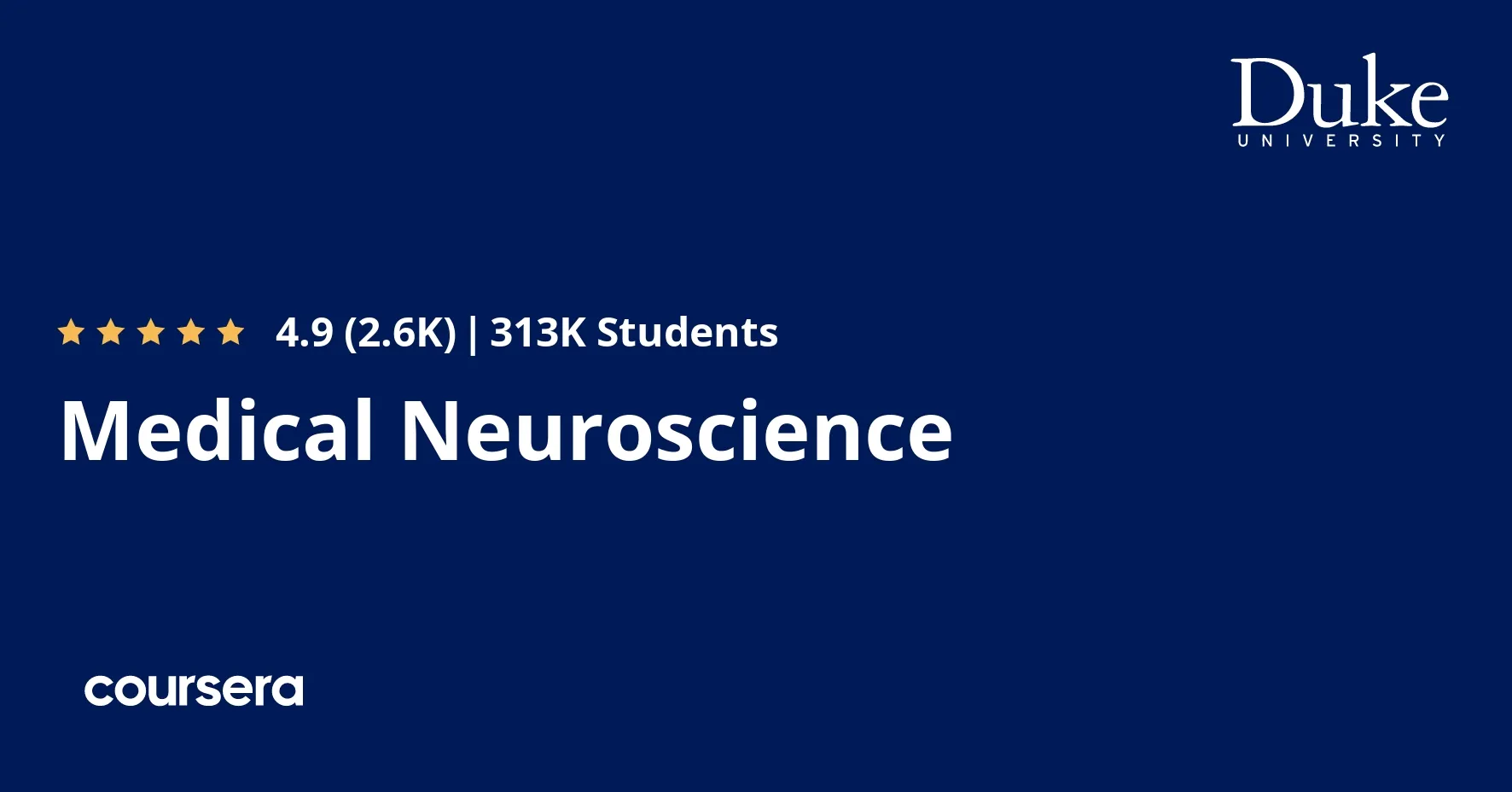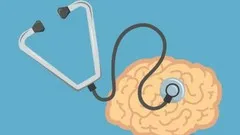
Medical Neuroscience 
Medical Neuroscience explores the relationship between the human central nervous system and behaviour, examining the functional organisation and neurophysiology of the system. Through this research, a neurobiological framework is developed to better understand human behaviour. ▼
ADVERTISEMENT
Course Feature
![]() Cost:
Cost:
Free
![]() Provider:
Provider:
Coursera
![]() Certificate:
Certificate:
No Information
![]() Language:
Language:
English
Course Overview
❗The content presented here is sourced directly from Coursera platform. For comprehensive course details, including enrollment information, simply click on the 'Go to class' link on our website.
Updated in [March 06th, 2023]
Medical Neuroscience is a course designed to provide students with an understanding of the neural systems in the brain and spinal cord that mediate sensation, motivate bodily action, and integrate sensorimotor signals with memory, emotion, and cognition-related faculties. Through this course, students will gain an understanding of the impairments that accompany central nervous system injury, disease, or dysfunction. The course will build on knowledge gained from prior studies in cell and molecular biology, general physiology, and human anatomy. By the end of the course, students will have a comprehensive understanding of the neural systems that mediate sensation, action, and cognition.
[Applications]
After completing this course, students should be able to apply their knowledge of medical neuroscience to a variety of clinical contexts. They should be able to identify and explain the neural systems that mediate sensation, action, and cognition, and be able to recognize and describe the impairments that accompany central nervous system injury, disease, or dysfunction. Additionally, students should be able to apply their knowledge of medical neuroscience to the diagnosis and treatment of neurological disorders.
[Career Paths]
1. Neuroscientist: Neuroscientists study the structure and function of the nervous system, including the brain, spinal cord, and peripheral nerves. They use a variety of techniques, such as electrophysiology, imaging, and molecular biology, to investigate the development, structure, and function of the nervous system. Neuroscientists are in high demand as the field of neuroscience continues to grow and develop.
2. Neuropsychologist: Neuropsychologists specialize in the study of the relationship between the brain and behavior. They use a variety of techniques, such as cognitive testing, to assess and diagnose neurological disorders. Neuropsychologists are in high demand as the field of neuroscience continues to grow and develop.
3. Neurologist: Neurologists specialize in the diagnosis and treatment of diseases of the nervous system. They use a variety of techniques, such as imaging and laboratory tests, to diagnose and treat neurological disorders. Neurologists are in high demand as the field of neuroscience continues to grow and develop.
4. Neurosurgeon: Neurosurgeons specialize in the surgical treatment of diseases of the nervous system. They use a variety of techniques, such as minimally invasive surgery, to treat neurological disorders. Neurosurgeons are in high demand as the field of neuroscience continues to grow and develop.
[Education Paths]
1. Bachelor of Science in Neuroscience: This degree program provides students with a comprehensive understanding of the structure and function of the nervous system. Students will learn about the anatomy and physiology of the brain, as well as the molecular and cellular mechanisms that underlie its functioning. Additionally, students will gain an understanding of the development, plasticity, and evolution of the nervous system. This degree is becoming increasingly popular as the field of neuroscience continues to grow and develop.
2. Master of Science in Neuroscience: This degree program provides students with a more in-depth understanding of the structure and function of the nervous system. Students will learn about the anatomy and physiology of the brain, as well as the molecular and cellular mechanisms that underlie its functioning. Additionally, students will gain an understanding of the development, plasticity, and evolution of the nervous system. This degree is becoming increasingly popular as the field of neuroscience continues to grow and develop.
3. Doctor of Philosophy in Neuroscience: This degree program provides students with an advanced understanding of the structure and function of the nervous system. Students will learn about the anatomy and physiology of the brain, as well as the molecular and cellular mechanisms that underlie its functioning. Additionally, students will gain an understanding of the development, plasticity, and evolution of the nervous system. This degree is becoming increasingly popular as the field of neuroscience continues to grow and develop.
4. Master of Science in Medical Neuroscience: This degree program provides students with a comprehensive understanding of the structure and function of the nervous system in the context of medical applications. Students will learn about the anatomy and physiology of the brain, as well as the molecular and cellular mechanisms that underlie its functioning. Additionally, students will gain an understanding of the development, plasticity, and evolution of the nervous system in the context of medical applications. This degree is becoming increasingly popular as the field of medical neuroscience continues to grow and develop.
Course Syllabus
Getting Started in Medical Neuroscience
Neuroanatomy: Introducing the Human Brain
Neuroanatomy: Surface Anatomy of the Human CNS
Neuroanatomy: Internal Anatomy of the Human CNS
Neural Signaling: Electrical Excitability and Signal Propagation
Neural Signaling: Synaptic Transmission and Synaptic Plasticity
Sensory Systems: General Principles and Somatic Sensation
Sensory Systems: The Visual System
Sensory Systems: Audition, Vestibular Sensation and the Chemical Senses
Movement and Motor Control: Lower and Upper Motor Neurons
Movement and Motor Control: Understanding the Paradigm of Eye Movements
Movement and Motor Control: Modulation of Movement
Movement and Motor Control: Visceral Motor Control
The Changing Brain: The Brain Across the Lifespan
Complex Brain Functions: Associational Cortex
Complex Brain Functions: Sleep, Emotion and Addiction
Course Provider

Provider Coursera's Stats at AZClass
Medical Neuroscience provides learners with a comprehensive understanding of the anatomy and physiology of the nervous system including the brain and spinal cord. They will learn about the different structures and functions of the nervous system and how they interact to produce sensation, movement and cognition. Learners also learn about the neuronal systems that regulate sensation, action, and cognition. They will learn about the different neural pathways and networks involved in these processes and how they interact to produce desired outcomes.
Discussion and Reviews
0.0 (Based on 0 reviews)
Explore Similar Online Courses

Personality Types at Work

Google Location Services on Android

Python for Informatics: Exploring Information

Social Network Analysis

Introduction to Systematic Review and Meta-Analysis

The Analytics Edge

DCO042 - Python For Informatics

Causal Diagrams: Draw Your Assumptions Before Your Conclusions

Whole genome sequencing of bacterial genomes - tools and applications

Control Your Subconscious Mind: Neuroscience Hidden Secrets

Perform an Excellent Neurological Bedside Exam

Brain and Behavioral Science Fundamentals
 Related Categories
Related Categories
 Popular Providers
Popular Providers
Quiz
 Submitted Sucessfully
Submitted Sucessfully
1. What is the overall goal of this course?
2. What is the main focus of this course?
3. What is the main purpose of this course?
4. Which of the following is the overall goal of this course?


Start your review of Medical Neuroscience